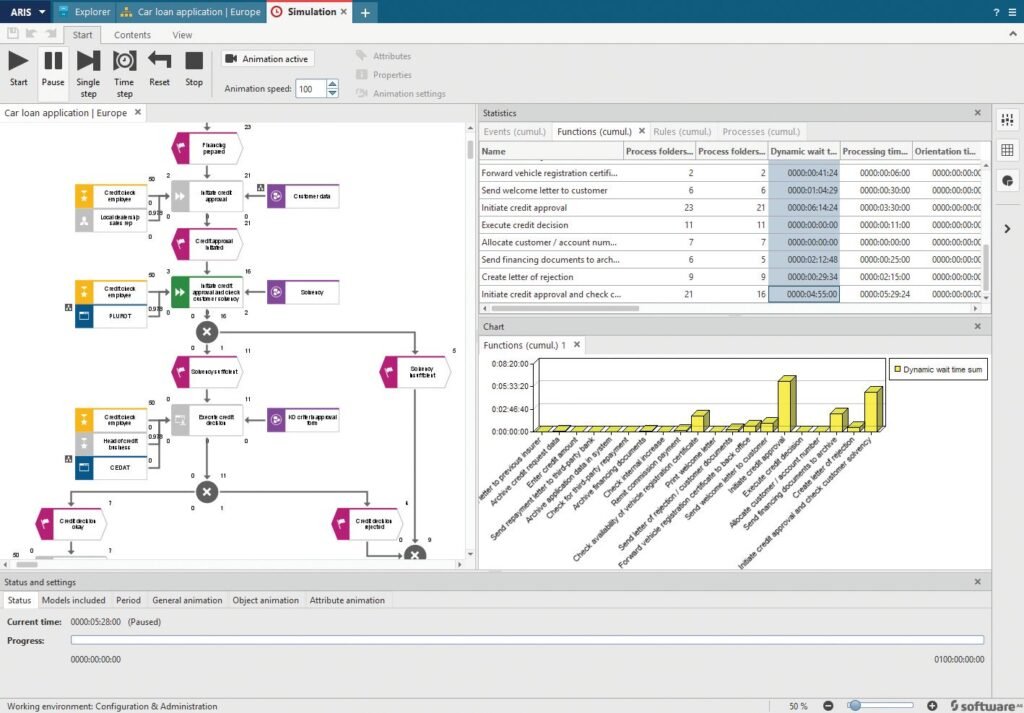ARIS Simulation: Optimize Processes and Enhance Efficiency

Where are the bottlenecks in your processes? What weaknesses might be holding you back? Which variations of your processes are the most effective? If these questions sound familiar, you’re not alone. Figuring out how to improve processes can often feel like guesswork, and that can lead to unnecessary risks. That’s where **ARIS Simulation** comes into play. This tool allows you to realistically simulate and analyze your business processes, helping you identify the best strategies for improvement before you make any costly changes.
Understanding ARIS Simulation
ARIS Simulation is designed to help organizations visualize their processes in a realistic manner, enabling them to experiment with different scenarios without the risks associated with real-world implementation. This simulation tool empowers users to conduct experiments with predefined queries, making it easy to obtain fast results and insights into process performance.
Key Benefits
- Easy Start: Get going quickly with simple experiments and pre-defined queries that deliver fast results.
- Spot Weaknesses: Uncover any weaknesses or bottlenecks in your processes.
- Best Practices: Identify what works best in your workflows.
- Test New Processes: Evaluate whether new processes can be executed efficiently.
- Optimize Resources: Improve throughput times and make the most of your resources.
- Resource Planning: Understand the resource requirements, utilization levels, and costs associated with your workflows.
- Informed Decisions: Review organizational decisions before putting them into action.
- Risk Analysis: Analyze potential risks within your processes.
- Benchmarking: Set benchmarks across your organization to measure performance.
- Deployment Planning: Plan the support and resources needed for successful implementation.
- Seamless Integration: Enjoy streamlined operations with full integration into ARIS Enterprise.
ARIS Simulation is perfect for reengineering, optimizing, and analyzing processes, as well as for benchmarking and resource planning. It helps you identify modeling errors, inefficiencies, and weaknesses through a variety of analyses.
Key features
Interactive Process Simulation
One of the standout features of ARIS Simulation is its interactive nature. Users can manage simulation runs easily through a toolbar or keyboard shortcuts, allowing them to start, pause, or stop simulations as needed. The ability to regulate process speed and execute simulations step-by-step provides a granular view of how changes impact overall performance.
Data-Driven Insights
During simulations, ARIS collects a wealth of statistics that inform decision-making. For instance:
- Function Stats: These reveal the number of executions and dynamic wait times within processes.
- Process Stats: Users can track completed process instances and throughput times.
The statistics are presented in user-friendly diagrams such as pie charts, bar charts, and line graphs, making it easier for stakeholders to understand complex data at a glance.
User-Friendly Diagrams
The statistics are displayed in simple pie charts, bar charts, and line graphs, making it easy for anyone to grasp the information at a glance.
Seamless Integration with ARIS Repository
There’s no need for extra modeling work. ARIS Simulation pulls process designs and data—like costs, times, and volumes—directly from the central ARIS repository. Since the tool is fully integrated into ARIS Enterprise, you can use the data already captured in ARIS as a foundation for simulating your business processes.
L-Sim® Simulation Engine
ARIS Simulation utilizes the L-Sim simulation engine from the Lanner Group, a leader in simulation software. This powerful engine allows for seamless integration within the ARIS framework without requiring additional software or complex data imports/exports. Users can simulate both Event-driven Process Chain (EPC) and Business Process Model and Notation (BPMN™) models, analyzing key performance indicators (KPIs) such as throughput times and utilization rates.
Simulate EPC or BPMN™ Models
ARIS Simulation allows you to examine Key Performance Indicators (KPIs) for your Event-driven Process Chain (EPC) or Business Process Model and Notation (BPMN™) models, helping you pinpoint any bottlenecks. Some of the KPIs you can analyze include:
- Process Throughput Times: Understanding how long it takes for processes to complete helps identify delays.
- Dynamic Wait Times: Recognizing bottlenecks allows for targeted interventions.
- Utilization Rates: Analyzing resource utilization ensures that capacities are effectively managed.
You can leverage this data to generate reports and charts that support both qualitative and quantitative analyses.

Examine key performance indicators (KPIs) in your Event-driven Process Chain (EPC) or Business Process Model and Notation (BPMN™) models to pinpoint any bottlenecks.

Additional Capabilities of ARIS Simulation
Beyond basic simulation functionalities, ARIS offers several advanced capabilities:
- Process Risk Simulation: Organizations can assess operational risks by simulating various scenarios that consider dependencies between business processes and potential risks involved.
- Resource Planning Support: Users can create organizational charts that break down human resources by roles involved in specific processes. This feature aids in planning resource allocation effectively.
- What-If Scenarios: The ability to simulate different resource profiles or changes in throughput rates allows businesses to quickly evaluate the likely impacts of proposed changes before implementation.
Real-World Applications
Organizations leveraging ARIS Simulation have reported significant improvements in operational efficiency and stakeholder satisfaction. For instance, Ooredoo Qatar’s Head of Process Management noted that using simulation has enhanced their gap analysis capability and facilitated continuous improvement efforts across their operations.
Similarly, Markus Lohrmann from Miltenyi Biotec B.V. & Co. KG remarked that adopting ARIS for business process management propelled their organization into new heights regarding process optimization.
Conclusion
ARIS Simulation stands out as a vital tool for businesses looking to enhance their process management capabilities. By enabling organizations to simulate processes realistically, identify weaknesses, optimize resource utilization, and analyze risks before implementing changes, ARIS Simulation significantly reduces the guesswork involved in process improvements.
With its user-friendly interface, integration with existing systems, and robust analytical capabilities, ARIS Simulation empowers organizations to make informed decisions that drive operational excellence. As businesses continue navigating an increasingly complex landscape, tools like ARIS Simulation will be essential for achieving sustainable success through effective process management.
